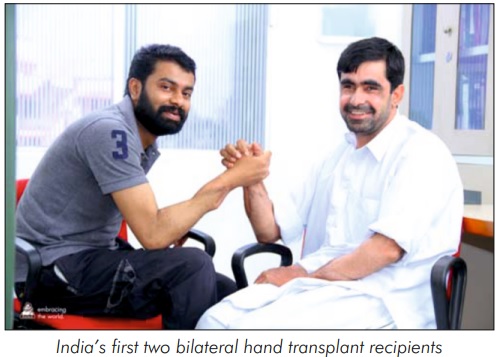Home / Newsletters / ITN 69 / Subscribe
Hand Transplant Programme in India - Progress and Future
Subramania Iyer
Indian Transplant Newsletter. 2023 Jul-Sep; 22(2):p4
Print ISSN 0972 - 1568
Online ISSN 3048 - 653X
PDF
Hand transplant has been accepted as one of the best methods of rehabilitation for the persons who have lost their hands. The alternate to hand transplants is prosthetic rehabilitation. And this is associated with lot of drawbacks which include high cost and difficulty to maintain them, chances of periodic breakdown, lack of availability, lack of sensations and fine motor movements and inconvenience to use due to its weight. Hand transplants like any other solid organ transplant needs lifelong immunosuppression with its attendant risks. Risk benefit analysis so far has been favourable for hand transplants in those with loss of both hands. For persons who have lost single hands this may not be true. Hand transplants are indicated for traumatic losses and preferably not for congenital absence. The outcome is best in distal amputations, even though it has been done at proximal levels as well.
The first hand transplant was carried out successfully at the Amrita Hospitals, Kochi on 13th January 2015(1) on a 27-year-old man who lost both his hands in a train accident two years prior to it. The hands were donated by the family of 25-year-old painting artist, who was pronounced brain dead after a road traffic accident. This new chapter in the history of organ donation and transplant in the country, paved the way for similar procedures in the same centre as well as others in the country.
Since then, six more centres have taken up hand transplants. In total 50 hands in 29 patients have been transplanted so far in India. Among them 21 patients had bilateral and 8 underwent unilateral transplants either with loss of dominant hand or transplanting on the other side was not possible due to technical reasons. All over the world, so far 18 countries have carried out hand transplants. The number of individual centres across the world is difficult to be ascertained as some countries have multiple centres performing them. Since its inception in 1999, USA topped the list (32 patients , 46 hands) but India has overtaken it both in terms of number of recipients as well as number of hands transplanted. All over the world, 112 patients have undergone transplants with 170 hands donated, this being an approximate number, since not all the hand transplants are reported and the reported success rate is 78%.

The issues plaguing widespread use of hand transplants across the globe is mainly the technical complexity, need for dedicated centres, financial unviability of the health system as well as the listing of recipients, chronic rejection in spite of immunosuppression, morbidity due to immunosuppression and lack of donors. In India, the majority of the patients who lose their hands are those who are victims of road traffic accidents or electric burns.
The precise number of such patients remains unknown; however, anecdotal evidence from numerous centers suggests a significantly high incidence. Although prosthetics, particularly those with Indian-made bionic hands available at more affordable cost, may offer some benefit for individuals who have lost limbs at the wrist level, they are not a viable solution for everyone, owing to various economic and technical constraints. Prosthetics are known for mechanical failure, difficult to master by all, do not allow the recipients to engage in productive activities and are cumbersome to wear when the amputation is at higher level. Lack of availability of hand transplant centres in all parts of the country is still a problem. This makes it imperative for the patients and their immediate family to stay in a faraway place for an indeterminate time, since the availability of suitable hands is still sparse and not predictable. Recently, more centres are showing interest in setting up hand transplant units and guidelines are now available from National Organ Transplant and Tissue Organization (NOTTO).
The cost of procedure in private health set ups and the subsequent cost of immunosuppressive medications are the major barriers faced by the hand recipients. State funding aimed at transforming unproductive individuals to productive members of the society could represent a viable solution. Transport of organs to a distant location is still difficult, but the national policy on usage of commercial aircraft as well as subsidised Heli-transfer and proactive involvement from police for provision of unhindered green corridor is a welcome sign. There needs to be more social awareness and involvement of NGOs and transplant coordinators for improving the donation rate for hands from potential donors which in turn can help to reduce the indeterminate and long waiting time. There are many countries which are war torn and having hand amputees but with no facilities performing hand transplants. Rethinking of policies concerning the allocation of hands to foreign recipients seeking hand transplants on humanitarian grounds is crucial.
Reference:
(1) Iyer S, Sharma M, Kishore P, et al. First two bilateral hand transplantations in India (Part 1): From vision to reality. Indian J Plast Surg. 2017;50:148-152
Available at:
https://www.itnnews.co.in/indian-transplant-newsletter/issue69/Hand-Transplant-Programme-in-India-Progress-and-Future-1249.htm
- Copyright © 2025. Published by MOHAN Foundation
